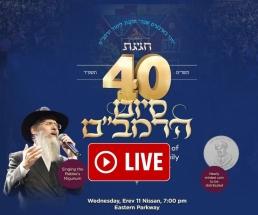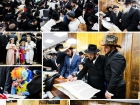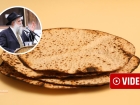The Third Way To Connect
“Everyone knows that a Chassid connects to the Rebbe through learning his Torah and following his directives; everyone knows that a Chassid must travel to the Rebbe.” But why don’t people know of the importance of “maamad” — the special method of hiskashrus where a Chassid supports the Rebbe with his money?” • A special interview the Rebbe’s secretary Rabbi Leibel a”h Groner gave to Beis Moshiach several years ago • Full Article
By Avrohom Reinitz, Beis Moshiach
I conducted this interview upstairs, in R’ Groner’s small office near gan eden ha’tachton. R’ Groner, who while still a bachur began assisting the Rebbe, became the Rebbe’s personal secretary from the earliest days of the nesius. In recent years, he often visited Chabad communities to inspire Anash and the tmimim to strengthen their fulfillment of the Rebbe’s takanos, especially in spreading the Besuras Ha’Geula and the belief that “hinei zeh Moshiach ba.” At farbrengens, he would relay stories that he himself witnessed or that he heard from the people they happened to, conveying a lesson with each story about strengthening hiskashrus to the Rebbe.
Even as I conducted this interview with him, he took the opportunity to teach the younger generation about how to connect to the Rebbe by fulfilling his hora’os. To one chassan he told the Rebbe’s hora’a about shemira before the wedding, to another chassan he told the Rebbe’s hora’os about wearing a gartel in the days before the wedding.
HISKASHRUS TO THE REBBE – NOW MORE THAN EVER
We haven’t seen the Rebbe in years and each passing day our yearning for king and Nasi grows along with the need to step up and strengthen the hiskashrus to our father, our king in thought, speech and action.
Yes. Throughout the years it was necessary to strengthen hikashrus to the Rebbe; all the more so now, as the Rebbe himself said in 5711 that when you are in double and redoubled darkness of the final galus, the need and necessity for hiskashrus to the Rebbe, the Tzaddik Yesod Olam (the righteous man who is the foundation stone of the entire world) is emphasized that much more. This is what empowers us to always be mekushar to the higher reality, without being fazed by changes in time or circumstance, Shabbos or weekday, day or night, the darkness of galus, etc.
Before talking about how to connect, we need to know to whom we are connecting.
There was a Chassid who went to the Rogotchover Gaon and asked him his appraisal of the Rebbe Rashab. The Rogotchover answered him that in order to appraise someone you need to be familiar with both things, the appraiser and the appraised. “Rebbe” is something that is beyond our conceptual grasp. We have no way of knowing and understanding what a Rebbe is. Therefore, how can I give you such an appraisal? But I can tell you one thing that I do know, the Rebbe does not go to rest at night (he did not say “to sleep,” but “to rest”) until he scans the entire world and when he sees a Jew who needs a bracha, he does not go to rest until he achieves, by Hashem, on behalf of that Jew.
You need to contemplate this and think, when one merits the privilege to connect to the Rebbe, who are you connecting with? You’re not connecting with the Rebbe’s lomdus (Torah scholarship), nor to his ge’onus (genius), nor to his tzidkus (piety), nor to his ruach ha’kodesh. As the Rebbe writes in his famous letter of 3 Tammuz 5710, “Many are those who seek and explain the qualities and greatness of the Chabad leaders in general and Nasi Doreinu, the Rebbe, my father-in-law, in particular, in various ways: a man of mesirus nefesh, a gaon, baal middos, tzaddik, who has ruach ha’kodesh, accustomed to miracles, etc. With all this, the main thing is missing.”
In that same amazing letter, the Rebbe provides the vocabulary to understand, in a small way, what a Rebbe is mainly about, “As in addition to that, which in essence is the main thing, and is especially important as it is that much more pertinent, and especially to us, the congregation of his Chassidim and mekusharim and that is, that he is Nasi, and a Chabad Nasi. For a Nasi in general is called Rosh Alfei Yisrael, he is the aspect of head and brain relative to them, and their nurture and life force is derived from him. By cleaving to him, they are connected with their root up above.”
The Rebbe goes on to write in his letter, “It is incumbent on each and every one of us all to know, meaning to deepen his consciousness and fix his thoughts on this, that he is the Nasi and head, from whom and through whom come all the material and spiritual flows, and by connecting to him (and the Rebbe had already instructed in his letters how and with what to connect), one is connected and united with the source and the source-source all the way higher and higher etc.”
THE MASHPIIM NEED TO SPEAK ABOUT “THE FOUNDATION OF HISKASHRUS”
The bachurim as well as the more learned yungerleit and even the older Chassidim attend farbrengens and look for any opportunity to strengthen their hiskashrus to the Rebbe. Their one question is, what else can be done to strengthen hiskashrus?
By the elder Chassidim there was a saying that the bond between Rebbe and Chassid is like the bond between husband and wife which can be executed in one of three ways: kesef – giving maamad money; shtar – learning his teachings and carrying out the Rebbe’s directives as well as writing a pidyon nefesh; and bi’ah – going to the Rebbe.
I don’t know why but in recent years there has been a weakening of the first method mentioned. Many Chassidim, especially those who are younger, are not aware of the way to connect through giving maamad money to the Rebbe. Similarly, many are unaware of the Rebbe’s special enactment regarding Keren Ha’Shana. Unfortunately, there are Chassidim today who have never built hiskashrus through giving of their money to the Rebbe.
You might be surprised to know that many more girls are aware of this. From Rosh Hashana until after Simchas Torah, many girls come to the office to give money for Keren Ha’Shana. Apparently their mashpios talk about it to them. Also, every erev Rosh Chodesh, they come from Hadar Hatorah (yeshiva for baalei teshuva) with maamad money. It’s the bachurim, the tmimim, who should be leading the way in all forms of hiskashrus. Why don’t they participate with maamad money and Kupas Rabeinu?
I was visited by a young man and I asked him about Keren Ha’Shana. He didn’t know what it was. I was taken aback. The Rebbe speaks about it every year in the sichos of Simchas Torah. This man, who is considered Chassidish, never heard of it!
It’s something that needs fixing and the mashpiim in yeshivos need to be aware that the young generation does not know enough about the possibility of connecting to the Rebbe in another way, through giving maamad money. The Rebbe Rayatz called it the “foundation of hiskashrus.” As he writes in his letter of 5628, “In truth, the inner aspect of this is the foundation of hikashrus of Anash and therefore, each of the mekusharim needs to know his obligation in paying monthly maamad …”
THE REBBE URGES CHASSIDIM TO GIVE MAAMAD
You merited to be present already during the nesius of the Rebbe Rayatz. What can you tell us about the giving of maamad at that time?
When I was a bachur, all the tmimim knew that one of the ways of hiskashrus is by giving maamad money. There was a bachur in yeshiva in charge of maamad, and every erev Rosh Chodesh he would make a list with the names of the bachurim and the amounts they gave and give the list to the Rebbe Rayatz. There were yungerleit who gave every Friday while others gave once a year.
In the seventh generation, after accepting the nesius, the Rebbe hardly spoke about giving maamad in sichos or letters but during the era of the Rebbe Rayatz, the Rebbe himself (then the Ramash) agitated about it a lot. Upon his arrival in the United States, he, the Rebbe, was appointed in charge of maamad.
They say that when the Rebbe farbrenged with Anash in Paris in 5707, he spoke a lot about maamad, as he wrote to R’ Nissan Nemenov:
“I said here in a farbrengen with Anash and the tmimim that hiskashrus needs to be through every possible faculty. First and foremost, by Chabad Chassidim, as the name implies, they need to connect with Chabad, that is, learning maamarim of the Nasi, since the intent of the one saying the maamarim is the drawing down of chochma-bina-daas into the middos and changing the middos thereby, which forces the hiskashrus by going in his ways and according to his instructions in the areas of middos, thought-speech-action.
But all this only affects a specific faculty or faculties, or in any event the revealed faculties. And therefore, since there is still doubt as to which path he is being led on (i.e. as far as his core essence), this inserts doubt as to where he is connected in his innermost being and essence.
The counsel for this is only through the matter of maamad (in this and other letters the Rebbe used the underground code term used in Soviet Russia of “nifneh,” which transposed Hebrew words through the letters that followed in the Hebrew alphabet) as it is explained in Tanya, chapters 34, 37, Igeres Ha’Kodesh, chapter 4 and elsewhere.
Now, all of the above applies even in normal times, and all the more so nowadays, when hiskashrus through Chabad, Chagas, Nahim, have suffered due to the suffering of the times, distance of place, and interruption of the correspondence even in writing for so many years, that there needs to be the hiskashrus through maamad with great measure and greater force..
In other letters from that time period, you can see how the Rebbe demands that Chassidim send maamad money to the Rebbe Rayatz. For example, in a letter to a Chassid, the Rebbe writes (Igros Kodesh volume 3, p. 392): “Surely you are doing and working on your travels also in the matter of maamad, for aside for this being part of your shlichus, it is known and we see tangibly that anything that has a hold in the material world too, lasts. This is one of the reasons that prophets would sometimes preface their prophecy with some physical action and as it is explained in several places in the latter prophets.”
I remember an amazing story that I heard from R’ Yaakov Katz, an American kid who became close with the Rebbe Rayatz during the Rebbe’s first visit to America. He said that around the year 5701, when he had yechidus, the Rebbe Rayatz asked him to give a very large sum toward the Rebbe’s activities. It was such a large amount that R’ Katz did not have it and he did not know what to do. He consulted with the Rebbe’s son-in-law, Ramash,who had arrived in America not long before, and after the Ramash explained the importance of the matter to him, he borrowed the large amount from friends and gave it all to the Rebbe Rayatz. After that, his business took off and he was miraculously successful. He said that when one has faith and trust in what the Rebbe said, you can experience unlimited success. I heard this story from the Rebbe himself in a farbrengen too, but the Rebbe did not mention the name of the Chassid that the story happened with.
THEY GAVE TO THE REBBE BEYOND THEIR MEANS AND HAD OPEN MIRACLES
Do you remember other stories in which the Rebbe said how much to give?
When they sold the pesukim of “Ata Horeisa,”there were some Chassidim who decided to give whatever the Rebbe told them to give, and the Rebbe agreed to that. But there were times that the Rebbe did not want to say how much. For example, I was standing near the Rebbe on Simchas Torah before they began selling the pesukim when a Chassid came over to the Rebbe and asked how much to give for a pasuk.
The Rebbe said to him, “You decide on your own. My hasagos (i.e. ideas of what is possible) are completely different hasagos. I don’t know whether you will be able to carry through. Better not to ask.” There were Chassidim who on Simchas Torah announced that they would give whatever the Rebbe said but after Yom Tov, when they came to ask how much the Rebbe wants them to give, the Rebbe told them to decide on their own.
There were even times when such instructions came unsolicited from above. For example, on Yud-Tes Kislev 5718, when the Rebbe unexpectedly made an appeal for the construction of the new neighborhood in Kfar Chabad the Rebbe demanded large sums and said the donations should be given that night or the next day.
Afterward, the Rebbe said, “In general, the system by me is that I don’t mix in and express my opinion about what everyone should give. I take what is given and one of two things will happen, either I’ll be satisfied or I won’t be satisfied and keep my dissatisfaction to myself. But since this is completely out of the ordinary, I will also go completely outside the routine and outside of the general rule, and if it seems to me that they are giving too little, I will remove the veil of shame and say – with the power of the matters that need the money (in this case, the shikun) – to add what I think they should … I am sure that Hashem will stand by His word for he said, ‘tithe so that you become rich,’ and he said, ‘test me please in this … and I will pour out blessing without end.’ Especially when this is about tzedaka for Eretz Yisrael which precedes tzedaka for outside of Eretz Yisrael, as the Alter Rebbe explains in Igeres Ha’Kodesh so that regarding this tzedaka there is added the psak din of our Rebbeim. If it seems to someone that he was ordered to give an amount he can’t handle, the intention is for Hashem to give him at least four times that and consequently, when another thousand dollars are added, Hashem will give him another four thousand dollars!”
Those present at the farbrengen wrote down their commitments and the Rebbe reviewed the notes. When the Rebbe got to R’ Dovid Deitsch’s note, he said, “Dovid Deitsch, double that.”
The Rebbe did not say what the original amount was but afterward, R’ Dovid told me that the original amount was $15,000, an enormous amount for that time, what a private home would cost. It was an amount that was well beyond his financial abilities and the Rebbe wasn’t satisfied with that and demanded double.
R’ Dovid did not think twice about it. In the morning, he rushed to the bank and asked for a loan of $30,000. The bank manager did not agree to such a loan without a collateral and R’ Dovid did not hesitate to mortgage his house, but his home was only worth $16,000 and he had to mortgage his business too. Only then did he get a bank check for $30,000. Thrilled, R’ Dovid went to the office and asked me to give the check to the Rebbe as soon as possible, before sunset, in order to fulfill the Rebbe’s request that the donations be made the day after the farbrengen.
A short while later, R’ Dovid got a phone call from a friend in Boston who told him about a fabric factory that went up in flames. The owner said that whoever wanted to could take bolts for free. R’ Dovid went there with a truck and loaded ten bolts of fabric. The owner suddenly showed up and asked how many bolts he was taking. R’ Dovid thought he took too many but the owner urged him to fill his truck with fabric. When he arrived at his own factory and opened the bolts, he discovered to his amazement that only the outer layers had burned and the rest could be sold. He also discovered that they were a type of particularly expensive fabric. He was able to sell the fabric and earn a huge profit of $90,000!
He repaid the bank loan and the rest of the money, $60,000, he wrote out on a check and asked for yechidus with the Rebbe. He gave the check to the Rebbe and said it was for him since the entire deal was done with the Rebbe’s blessing. The Rebbe accepted the check and asked: R’ Dovid, this is for me? When he was told yes, the Rebbe said to him: Take the check and put this amount into your bank account and may Hashem grant you success! After that, R’ Dovid did well in business and became rich.
A similar story happened with R’ Gimpel Orimland who became close with the Rebbe after he had a major miracle with the Rebbe restoring his son to life. One year, he was with the Rebbe on Shabbos Bereishis when the gabbai of the shul was selling mitzvos and he wanted to donate $1,000.
The Rebbe suddenly said to him: I don’t want to take from you. Afterward, the Rebbe said, you need to give $5000. When he agreed, the Rebbe asked whether he gave it happily. When he said yes, the Rebbe blessed him that the following year he should be able to give keifel-kiflayim (double-double)
The truth is that he did not have $5000 but when he returned home and told his wife, she took her jewelry and said, go and pawn it and quickly bring the money to the Rebbe.
The following Elul, he did not even have money for a plane ticket. He did not understand how he would be able to give double-double what he gave the previous year, but a few days before Succos, he signed on a big business deal and the down payment that he got was $20,000, exactly double-double the $5000 he gave the year before. [He ended up coming to the Rebbe for Simchas Torah and he bought the second verse, for “whatever amount the Rebbe sees fit” but to his surprise, when he had yechidus and wanted to know the amount, the Rebbe told him to give just $126. The Rebbe added that he had been precise in the words that he said the previous year when he did not say to donate double-double, only that he would be able to give double-double. For some reason, the Rebbe decided he should only give $126. As for the rest, the Rebbe said he could it give to whatever tzedaka he wanted.]
But all these are unusual stories. Usually, the Rebbe did not get involved in amounts and did not even want to know how much came in and how much each one gave. With some of the appeals at farbrengens, the Rebbe stressed that they could write the amount on one paper and their name and mother’s name could be written on a separate paper so that when the name was read at the tziyun, the amount of the donation would not be known.
HOW DO YOU ENTER THE “TEIVA” OF THE REBBE? THROUGH MAAMAD!
If the Rebbe did not urge on the Chassidim about maamad, then who did?
Some of the people in charge of maamad in New York were R’ Moshe Pinchas Katz and R’ Mordechai Mentlick and they spoke about it at farbrengens. Aside from them there were also shadarim, shluchei d’rabbanan, who traveled from place to place to collect maamad money from Chassidim, like R’ Shmuel Dovid Raitchik in the United States, Rabbi Zev Menachem Gringlas in Canada, R’ Benzion Shemtov in England. R’ Shlomo Chaim Kesselman was also in charge of maamad for a while.
As mentioned, these Chassidim in the time of the Rebbe Rayatz, got prodding letters from the Rebbe with amazing turns of phrase and these messages were conveyed further for many years. In one of his letters to R’ Gringlas, the Rebbe writes that he should be careful with his avoda for Merkos L’Inyonei Chinuch or his work for Machne Israel that they shouldn’t come at the expense of his work for maamad, and the Rebbe added, “And obviously, it is necessary to be careful about this.”
In a letter to R’ Benzion Shemtov, the Rebbe instructs him not to limit maamad to Chabad Chassidim: “There is no need to be stringent and sift thirteen times before talking about maamad” – for the Rebbe pertains to all Jews “and especially when you take note that in recent years it is emphasized even more how he is the leader of Klal Yisrael,” “However, on the other hand, don’t speak about it with just anyone; obviously be wary of those who will crow afterward ‘I made Avram rich.’”
Similarly, the Rebbe wrote to R’ Nissan Nemenov, “I don’t know the reason or who is at fault but apparently maamad in your current country is not in the state that it ought to be, and it certainly could be with the proper efforts. It is impossible from a distance to know clearly the ways to correct this, especially when I am not so familiar with the quality of people who you need to involve in this and their personal circumstances. You know them and are on site so it would be proper and perhaps even essential that you expend the necessary effort in the proper manner in bettering the maamad situation and its improvement to the extent possible. My view from way back is known regarding the need to expand the circle of participants in maamad and not to limit it only to tmimim and the like.”
Twice a year, there was a special melava malka meal at my parents’ home for raising maamad money in the course of which elder Chassidim spoke about its importance. They spoke about the difference between supporting Tomchei Tmimim and maamad, that the Rebbe Rayatz once said: Maamad is the head and Tomchei Tmimim is the heart and the order is, first the head and then the heart.
Although fifty years have passed since then, I remember what my wife’s uncle, R’ Moshe Leib Rodstein, said. He was the secretary of the Rebbe Rayatz and then of the Rebbe. He said that during the tefillos of Rosh Hashana, we say the verse, “And G-d remembered Noach and all the wild and domesticated animals that were with him in the ark.” he explained it to mean that when Hashem remembered Noach, He naturally remembered all those who were with him in the ark, similarly when Hashem remembers the Rebbe, and this happens every second, Hashem remembers all those who are in the Rebbe’s ark. That means that when you are in the ark already, the situation is good. The big question is, how do you get into Noach’s ark? One of the ways is by giving maamad money!
I was a young man at the time and till today I remember how he repeated this emotionally: How do you get into the Rebbe’s ark? Through maamad!
MAAMAD, KEREN HA’SHANA, MAGBIS, DIMEI P”N
On R’ Groner’s desk was a small notebook that was printed by the Kupas Rabeinu branch in Eretz Yisrael, which listed the options of being partners with the Rebbe’s work every month whether through maamad, Keren Ha’Shana, appeals made on special days in the calendar, and money for pidyonei nefesh.
Please explain the differences between the four options.
The custom to include money with a pidyon nefesh is an ancient one from the time of Moshe Rabeinu. When they asked for Moshe or Aharon’s blessing, they would give a sum of money as “kofer nefesh” (atonement for the soul). The source for the custom is the Ramban on Torah who writes regarding the counting of the Jewish people by Moshe and Aharon by way of giving half-shekels, “For one who comes before the father of the prophets and his holy brother, and he becomes known to them by name, this would be for him a source of merit and life, because he enters into the conceptual notion of nation and is inscribed among the Bnei Yisrael and the merit of the multitude in their number. And so for each of them it was a merit to be counted in number before Moshe and Aharon, so that they may place their gaze upon them for the good, ask for mercy on their behalf, may G-d the G-d of your fathers increase your number a thousand times more and not diminish your numbers and the shekalim are an atonement for your souls.”
This custom was established and took on greater import with the start of the Chassidic movement as Chassidim submitted pidyonei nefesh to their Rebbes and appended money. It should be noted that I heard from the Rebbe a number of times that when it is not possible to give money for the p’n to the Rebbe, the money can be given to one of the Rebbe’s institutions and this is considered like the Rebbe receiving the money.
***
The custom of maamad was established by the Alter Rebbe in the time of Rabbi Menachem Mendel of Vitebsk when the latter traveled to Eretz Yisrael with a large group in the year 5537 and encountered financial difficulties. The Alter Rebbe, who had started leading Chassidim in Russia, speedily came to the help of the group by starting maamad. The general meaning is giving money to the Rebbe to maintain his household.
Together with two other great disciples of the Maggid, the maamad fund began to operate. These three tzaddikim enacted that every house have a box (pushka) and every family had to make regular donations. At first, the enactment was to set aside maamad before every holiday but then it was established that maamad money be set aside in the box every week.
Since then, Chassidim continued giving maamad for the Rebbe, the Nasi of that generation. As the Mittler Rebbe wrote to the Chassidim, “For every man to send his maamad money… and I am confident in the true power of hiskashrus.”
The Tzemach Tzedek encouraged the Chassidim to continue following the enactment of the Mittler Rebbe, “And the main thing is to put up closed pushkas and to gather a bit every week, at least once a month, and what is missing according to the enactment should be filled by each person each month, so that it will not be difficult for them at the end of the year.”
The Rebbe Maharash, despite conducting himself in a manner of extreme wealth, once said that maamad is “more precious than all that is precious.” Another time, he said that although he earned several thousand a year on the stock market, “the pleasure of bread from heaven is from maamad money.”
In one of his letters, the Rebbe explains maamad in a simple yet amazing way in order to be able to explain it to those who are not Chabad Chassidim: There needs to be an explanation, for not everybody has the wherewithal to take part in the holy work of the Rebbe [Rayatz], which is actually the obligation of every Jew. By giving maamad: 1- They remove this preoccupation (the preoccupation of financial expenses) from him so that it not be a distraction to divert him from his avoda, 2 – primarily, through this one takes part in his holy work, and from this aspect the giving needs to be in a different way and a different quantity.
Indeed, over the years, the Rebbe distributed part of the maamad money to the activities of his institutions. Following that, we continue giving the money from maamad to the Rebbe’s institutions.
When Chassidim continue giving maamad even after 3 Tammuz, although they do not physically see the Rebbe, it expresses our hiskashrus to the Rebbe, without any changes! As the Rebbe mentions in a letter that was referred to before, by doing so we merit to take part in the Rebbe’s holy work.
***
The custom of holding magbis (appeals) began in the time of the Rebbe Rashab. On Purim they would make an appeal for a specific fund, Kupas Rabeinu, which was for specific things. Over the years, the Rebbe added additional appeals on various special days in the calendar such as an appeal for the Reshet Oholei Yosef Yitzchok at the 12 Tamuz farbrengen; an appeal for Keren Torah on 10 Shevat. Over the years, many more appeals were added so that in recent years, the Rebbe made an appeal on every special calendar day with a total of twenty-six appeals every year.
***
Keren Ha’Shana is the only one of the four that was started by the Rebbe which makes it particular cherished. To Chassidim there is a special fondness for what our own Rebbe founded and revealed.
The first time the Rebbe spoke about Keren Ha’Shana was on Shabbos Bereishis 5714. The Rebbe explained that in order to perpetuate the hamshachos of the month of Tishrei over the rest of the days of the year, we need to give tzedaka every day. Since we do not always remember to give tzedaka daily, the Rebbe founded Keren Ha’Shana toward which you donate in amounts corresponding to the number of days of the year, and the Rebbe distributes tzedaka every day from this fund as a merit for all the donors.
As the Rebbe put it, “Since this year is a leap year and it has 383 days, I suggest that everyone give this amount to tzedaka with half a cent, a cent, a nickle, a dime, a dollar, a hundred dollars, eighteen-hundred dollars (of course, every country using the currency of that country). This will be the channel for the positive hamshachos materially and spiritually throughout the year. Those who want to rely on me can give this tzedaka for me to do with as I see fit, to the fund that I have and from this general fund money will be disbursed every day and ultimately, every donation will reach its rightful place.” The Rebbe stressed that when giving to this fund, one could also make up tzedaka giving for the past.
The Kupas Keren Ha’Shana was founded from 5714 and by the Rebbe’s instruction R’ Chadakov issued a check from the fund twice a day to tzedaka, before shacharis and before mincha, on behalf of all the donors. On Friday, the sum on the check was doubled to be for Shabbos too.
Today too, in accordance with instructions we received from the Rebbe, we write two checks a day and together with Rabbi Sholom Mendel Simpson (since deceased), we both sign the checks.
SUPPORTING THE WORK OF THE SHLUCHIM AND THOUSANDS OF LUBAVITCHER FAMILIES
As we spoke, the phone rang in R’ Groner’s office. Half a minute later, a down-and-out person appeared in his office who asked R’ Groner for help. After R’ Groner gave him money from the fund, he sighed and said that in recent years, many of Anash have been approaching the fund for assistance. R’ Simpson and R’ Groner would check out the families’ situations and in accordance with instructions from the Rebbe over the years, would help these families.
“The public has no idea how many Lubavitcher families need food. The fund also provides support for hundreds of shluchim including many who would not have what to eat if not for this fund. For Pesach, for example, we provided funds for hundreds of families. I’m not talking about a hundred dollars of support; it’s several hundred dollars. In more serious cases, it’s over a thousand dollars for families of shluchim. In conversations we have with people involved in chesed who know the families, they say that if not for the check from Kupas Rabeinu, these shluchim would not have the means to make it through the holiday.”
How has the state of the American economy affected the fund?
Rabbi Groner sighed.
“In recent years, donations have gone down and requests have gone up. At the height of the economic crisis, there were some particularly difficult weeks. Two people who used to give $40,000 a year lost their money and told us that they cannot give their annual donation. There was a Chassid who donated $5000 every year who stopped giving two years ago. Before Pesach, he came to me and sadly told me that he himself needs help from the fund.”
And yet, there is a ray of light. There are those who are not Lubavitcher Chassidim, but who realize the importance of contributing toward the Rebbe’s fund, one of whom looks like a hippy but every year he comes to the office between Rosh Hashana and Yom Kippur and gives $3850 if the year has 385 days, etc. He did not learn in Tomchei Tmimim but says, “A fund that the Rebbe started is the first order of priority to me. Every day, I put money aside so that at the beginning of the next year I can give the money to the Rebbe’s fund.”
What is your message to Anash?
We spoke about the need to connect to the Rebbe whether through maamad and Keren Ha’Shana, learning his Torah, and doing his hora’os. Of course, traveling to the Rebbe and writing panim and duchos (reports). For the hiskashrus to be with a pnimiyus, we always need to think and meditate upon our bond with the Rebbe.
One of the points that can inspire hiskashrus is the thought that the Rebbe sees and knows what is happening with us. The Rebbe knows what we are doing, what we are saying, and even what we are thinking.
I will tell you a story that happened many years ago. Shortly before Shavuos I got a phone call from someone who said he was a Litvishe yungerman. He wanted to meet with the Rebbe in the special yechidus for guests after Yom Tov in order to consult with the Rebbe about his daughter. I asked him where he would be staying for Yom Tov and he said with a friend in Manhattan.
I explained that this yechidus was only for guests who stayed with the Rebbe for Yom Tov and he would have to wait his turn for a regular appointment. He begged me to allow him to join the upcoming yechidus saying that his daughter had a serious problem and that he borrowed money and made a special trip from Eretz Yisrael for this yechidus. In the end, I agreed to include him on condition that he stayed no longer than five minutes. At first he said that five minutes would not be enough for him to say everything he wanted to say to the Rebbe but when he realized it was his choice to either accept the five minute limitation or not go in at all, he accepted it.
Before the yechidus, he showed me the small note on which he had written his questions to demonstrate to me that he had no intentions of staying too long in the Rebbe’s office. I told him he did not have to show me his questions. He just had to hurry up because other Chassidim would be waiting for their turn.
He ended up staying in the room for fifteen minutes.When he left, he apologized for the delay and said in amazement that if he had not seen the Rebbe’s ruach ha’kodesh with his own eyes, he would not have believed it. Other men and bachurim gathered round and he said:
After you told me that I was limited to five minutes, I sat with my friend in Manhattan and went through the list of questions I wanted to ask the Rebbe. Out of fifteen questions, I copied only five of the most important ones. I left the complete list in Manhattan.
“When I went in for yechidus, I handed over my list of five questions and the Rebbe began to answer them. I expected the Rebbe to answer my questions but the Rebbe began talking about various topics. At first, I did not understand what was going on. I thought of my friends in the Litvishe yeshiva who always laugh at the Rebbe and thought maybe they’re right, but then I caught on. The Rebbe was actually answering the first question on the list I left in Manhattan! When he finished answering the first question, he went on to the second question which was also not written on the paper I had handed him. For the first seven minutes of the yechidus, the Rebbe answered ten questions that were on the list in Manhattan. Then the Rebbe began responding to the questions I had written and given to him.”
***
The Rebbe does not need us to tell him what we are doing. He thinks about us and knows everything. This ought to strengthen each one of us to realize the extent that we need to be mekusharim to the Rebbe. On the one hand, it is a great zechus that the Rebbe is always with us and protects us. Knowing this should strengthen us because surely the Rebbe provides us with strength to be as we ought.
On the other hand, we need to know that along with the zechus and strength, we have a great responsibility. Each of us needs to ask ourselves whether our behavior in thought, speech and action comports to the Rebbe’s wishes, for the Rebbe sees and knows all.
Let us make a cheshbon ha’nefesh (spiritual accounting) as to where we stand in our hiskashrus to the Rebbe. Let us strengthen ourselves in all of the Rebbe’s takanos including participating in the Rebbe’s work through maamad and Keren Ha’Shana.
As the Alter Rebbe says in Tanya, when a person gives tzedaka, he elevates all his soul powers since he worked with all those powers to obtain that money and he could have used the money for his own purposes. So too, when a Chassid gives of his money to maamad or Keren Ha’Shana, he connects all his soul powers to the Rebbe.
May the results and resolutions resulting from this conversation connect us more to the Rebbe and get us to do what the Rebbe wants of us. May we use the kochos the Rebbe gave us to strengthen ourselves and to light up the neshama of every single Jew so not one Jew remains without a connection to Torah, mitzvos and Hashem. All this will further hasten the revelation of Moshiach and we will merit to see the Rebbe and he will redeem us.
*
Kupas Rabbeinu, an organization so dear to the Rebbe, continues its charitable actions after the passing of Rabbi Groner and Rabbi Simpson. It is now directed by the Groner family, Mr. Shmuel Malamud and Rabbi Yosef B. Spielman, following the guidelines set by its founder, the Rebbe Melech HaMoshiach that were given over to the mazkirim who ran it over the years.
Checks can be made out to: KUPAS RABBEINU and mailed to P.O.B. 288, Brooklyn, NY 11225, or you can use the website kupasrabeinu.org to process your maamad, Keren Hashana, Magbis or any other donations and take part in furthering the causes dear to our Rebbe.
*
The magazine can be obtained in stores around Crown Heights. To purchase a subscription, please go to: bmoshiach.org
445
Join ChabadInfo's News Roundup and alerts for the HOTTEST Chabad news and updates!










































